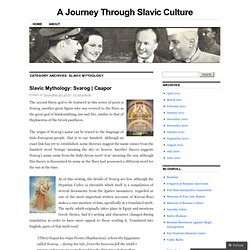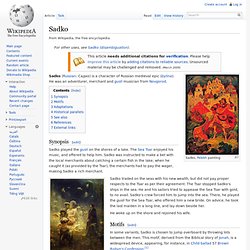

Slavic Mythology - Mythology Dictionary. A Journey Through Slavic Culture. This post is the beginning of a series of articles on various aspects of Slavic mythology that I hope to publish on a near-weekly basis.

As this article is the beginning of something new, I believe I should begin with the greatest figure in the Slavic pantheon, Perun. Often compared to Thor of the Norse mythological world, Perun was considered the highest of all gods and was one of Svarog’s three sons. Perun was seen to be the creator and master of rain, lightning, and thunder (and anything that had to do with hurricanes and storms), Perun’s name is even based off the old Indo-European root “parg” meaning ‘to strike’, much like lightning would. In fact, the Polish word for ‘thunderbolt’ is Piorun. He possessed the ability to shoot lightning strikes from a bow as well as create storms to aid farmworkers. It is said Perun was born to the Mother Sva (or the goddess Lada), after she consumed a Pike fish containing an embodiment of Rod, the creator god.
Main/Slavic Mythology. Main/Russian Mythology and Tales. List of Slavic mythological figures. This is a list of Slavic deities, spirits and mythological creatures.

Deities[edit] Major gods[edit] Other gods[edit] Spirits and demons[edit] Creatures[edit] See also[edit] Category:Russian mythology. Sadko. Sadko (Russian: Садко) is a character of Russian medieval epic (bylina).

He was an adventurer, merchant and gusli musician from Novgorod. Synopsis[edit] Sadko played the gusli on the shores of a lake. The Sea Tsar enjoyed his music, and offered to help him. Sadko was instructed to make a bet with the local merchants about catching a certain fish in the lake; when he caught it (as provided by the Tsar), the merchants had to pay the wager, making Sadko a rich merchant.
Sadko traded on the seas with his new wealth, but did not pay proper respects to the Tsar as per their agreement. He woke up on the shore and rejoined his wife. Motifs[edit] In some variants, Sadko is chosen to jump overboard by throwing lots between the men. Slavic mythology. Many generations of Slavic artists were inspired by their national folklore: Ilya Yefimovich Repin, Sadko in the Underwater Kingdom (1876) Slavic mythology is the mythological aspect of the polytheistic religion that was practised by the Slavs before Christianisation.

The religion possesses many common traits with other religions descended from the Proto-Indo-European religion. Old Slavic religion evolved over more than a thousand years and some parts of it were from neolithic or possibly even mesolithic times. The Earth was worshipped as Mat Zemlya and there were no temples. Rituals were performed in nature. Modern wooden statue of Perun, the god of thunder and lightning, Ruthenia Sources of information[edit] Unlike Greek, Indian or Egyptian mythology, there are no first-hand records for the study of Slavic mythology. Written sources[edit] Artistic representation of Saxo Grammaticus.